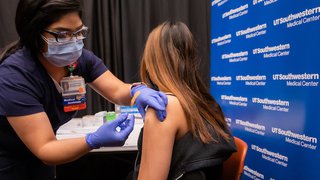
When I was in medical school, I didn't even own a cellphone. Now we treat many UT Southwestern heart failure patients almost exclusively through video visits on their mobile devices or home computers.
Though the shift from in-clinic to virtual heart failure care is largely due to the COVID-19 pandemic, evidence-based research and patient satisfaction tell us that video visits for heart failure care are effective and here to stay.
The majority of the visit we might have in the office can be done remotely. We can do a comprehensive history, review your medications, discuss any symptoms you are having, and complete a thorough physical examination. The exam can include assessment for jugular venous distension (JVD), bendopnea, edema, and orthopnea, for example.
In other words, virtual visits for heart failure are not merely an online chat with your heart failure provider. These visits are extensive, effective evaluations of your cardiac health.
In April 2020, I co-authored a position statement from the Heart Failure Society of America that outlined the benefits, challenges, and some of the logistics of virtual visits for heart failure in order to provide guidance to our community. We believe video visits can benefit our patients and may be able to help prevent hospitalizations as well as improve adherence.
Some people are hesitant at first to use video visits because they are unsure of the quality of the care they will receive. However, after having done a virtual visit, the majority are pleased with the convenience and thoroughness of the care they have received in the comfort of their homes or workplaces.
Get to know Dr. Thibodeau
Jennifer Thibodeau, M.D., is the Medical Director of UT Southwestern's Heart Failure Program. Her clinical and research activities are focused on heart failure treatments and physical examinations, left ventricular assist devices (LVADs), and cardiac transplantation.
Video exams for heart failure: What to expect
Prior to your video visit, a staff member may walk you through downloading the secure video software and conduct a "test visit." If you have weakness or mobility challenges, it might be helpful to have a loved one join the visit in person to help position your camera, adjust the lighting, and assist with maneuvers or position changes that may be required during the exam. Patients can also share the secure video link with any family members they would like to attend the video visit. (This has been particularly helpful during the pandemic.)
When your heart failure physician is doing a physical exam, she or he is looking for signs of extra fluid accumulation or signs that your heart is not getting enough blood and oxygen to the rest of your body. Heart failure is a syndrome marked by a tendency to accumulate fluid in the lungs, belly, or legs. As such, a major part of a video examination will include efforts to evaluate for this.
To evaluate for extra fluid, we typically assess jugular venous distension, hepatojugular reflux, bendopnea, edema, abdominal distension, or orthopnea. To assess how well your heart is delivering blood and oxygen to the rest of your body, we may consider your level of alertness or how well you are thinking and may evaluate your blood pressure – specifically the difference between the top number (systolic) and the bottom number (diastolic) of your blood pressure.

Jugular venous distention (JVD)
The jugular vein is the large vein in your neck. Evaluation of this vein tells us a lot about the fluid or pressure in your heart.
I often tell patients that the neck veins are like a pressure gauge for the heart. When there is increased pressure in the heart, the jugular vein becomes distended and more visible. The higher I can see the neck veins, the higher the pressure inside the heart. Usually, a reading of 10 mmHg (or about 14cm) is cause for concern and might suggest that you have too much fluid.
You might think examining your neck veins over video would be difficult. However, when we looked at that specific issue, the research letter we published showed that remote assessment of JVD is nearly as effective as an in-person JVD exam, with 95% accuracy.
Hepatojugular reflux
We measure hepatojugular reflux by pressing down on your abdomen to see if your neck veins distend and go higher on your neck. If you have this, it might also indicate you have extra fluid. Therefore, we may ask you to press and hold down on your abdomen while we are looking at your neck in order to evaluate for this.
Bendopnea and orthopnea
My colleagues and I described bendopnea in 2014 as the sensation of becoming short of breath when you bend over at the waist. Many patients with heart failure experience this symptom, and it can indicate you have fluid accumulation.
To test for bendopnea, we’ll ask you to sit down and bend forward as if you’re putting on shoes or socks. We will ask you to make sure you don’t inadvertently hold your breath while bending (because that can also make you short of breath!), and we will ask you to tell us if you get short of breath. If you become short of breath within 30 seconds of bending, we would say that you have bendopnea.
Orthopnea
We will ask about orthopnea, or shortness of breath when you’re lying flat, and may have you demonstrate that. We may ask you to lie on your couch or recline in your chair to see if you become short of breath. This also might indicate that you have fluid accumulation.
Edema
Some heart failure patients have swollen legs or ankles, called edema, which might indicate you have extra fluid in your body. To check for edema, we'll ask you to point the camera at your legs and feet. We may ask you to press your thumb on your leg. If there is an indentation when you pull your thumb away, you may be retaining fluid.
Blood pressure
If you have a blood pressure cuff at home, we will ask you to check and log your blood pressure regularly, particularly before your visit. If your blood pressure is acceptable, we may be able to increase your heart failure medications because we know you get the most benefit to your heart from these medicines at the highest tolerated doses.
However, if your blood pressure is low, or if the difference between your top and bottom numbers is small, we may be concerned that your medications need adjusting or that your heart is not pumping enough blood to the rest of your body.
What happens after a video visit?
Based on the video visit, we may recommend that you continue with your current regimen, start a new medication, or adjust the dosage of drug you’re currently taking. Through MyChart, we’ll be able to share follow-up instructions and address any additional questions you may have.
In some cases, we you may need to come to the clinic for:
- Imaging or procedures: Echocardiograms, heart catheterizations, and cardiac magnetic resonance imaging (MRI) can't be done through video visits. You'll need to come to the clinic or the hospital for these.
- Concerning symptoms: If there are findings during your virtual visit that we feel cannot be addressed remotely, we may ask you to come for an in-person visit or refer to you to the Emergency Room, although this would be rare.
If you do need to come to the clinic, UT Southwestern has extensive safety precautions and protocols in place to reduce the risk of COVID-19 exposure.
The future of video visits
Video visits are here to stay. The next challenge is to integrate more heart failure exam tools into remote care.
Digital technologies that help monitor patients from home are advancing quickly and in the future we hope standard care for heart failure patients will include devices such as:
- Digital stethoscope
- Glucometer to measure blood glucose levels
- Heart rate monitors
- Pulse oximeter
These tools, and others, would be designed to securely transmit the patient's health data directly to their provider and make it easier to adapt treatment plans when necessary.
Wearable devices are also becoming more sophisticated and can help track arrhythmia, blood pressure, respiratory fitness, oxygen levels, and much more, providing other tools for remote monitoring.
A portable EKG is an intriguing tool, too, that integrates with a patient’s smartphone to generate readings that can be shared with the provider.
Five years ago, I was among the many specialists who felt strongly that heart failure exams could be done only in person. Today, I believe video visits have become a vital link during the pandemic, opening a continuum of care to our most vulnerable patients – protecting their health and ours.
Beyond COVID-19, virtual visits will continue to provide effective specialty care and undeniable convenience to patients.
I can't imagine the future of heart failure care without them.
To request a video visit for heart failure care, call 214-645-8300 or request an appointment online.
The faces of heart failure
Heart failure can affect people at nearly any age in their life. UT Southwestern has the expertise to treat even the most complex heart failure patients. In this video, you'll meet three of them who turned to UT Southwestern for their care. "It takes a village to take care of patients," says Linda, who needed a heart transplant after giving birth. "And UT Southwestern has that village."











